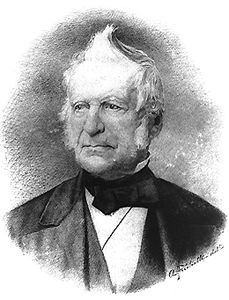In 1837 and 1838, insurgents in Upper and Lower Canada led armed rebellions against the Crown. The two uprisings left 325 people dead. The revolt in Lower Canada was more serious and violent than the rebellion in Upper Canada. The events of 1837 led to the Durham Report (1839). It led to the Act of Union in 1841. The Act merged the two colonies into the Province of Canada. It also led to responsible government. These were important steps in Canada’s path to becoming a country.
This article is a plain-language summary of the Rebellions of 1837–38. If you would like to read about this topic in more depth, please see our full-length entry: Rebellions of 1837–38.
Rebellion in Lower Canada
The rebellion in Lower Canada was led by Louis-Joseph Papineau and his Patriotes. More moderate French Canadian nationalists were also involved. Together, they had the most seats in the elected Legislative Assembly. Since the 1820s, they had opposed the Catholic Church. They wanted control over the colony’s spending. They also challenged the British governor and his unelected advisers. (See Château Clique.)
Papineau and the Patriotes’ demands included calls for responsible government. These were rejected in England. Meanwhile, French Canadian farmers suffered through an economic depression in the 1830s. In the urban areas, tensions rose between French Canadians and anglophones. All of this led to protests across the colony. The more radical Patriotes called for armed rebellion.
There were two outbursts of violence. The first was in November 1837. Patriote rebels fought British troops and anglophone volunteers in a series of skirmishes. The defeat of the rebels was followed by anglophone looting and burning of French-Canadian homes. Papineau and other rebel leaders fled to the United States.
A second rebellion began in November 1838. It had the help of some Americans. (See Hunters’ Lodges.) But it was poorly organized and was quickly put down. It was followed by more looting in the countryside.
The two uprisings left 325 people dead. All of them were rebels except for 27 British soldiers. Nearly 100 rebels were captured. After the second uprising failed, Papineau left the US for exile in Paris.

Rebellion in Upper Canada
The rebellion in Lower Canada inspired anglophone radicals in Upper Canada to take their own action against the Crown. Their revolt was smaller and less deadly.
The rebellion in Upper Canada was led by William Lyon Mackenzie. A newspaper publisher and politician, he was a fierce critic of the Family Compact. It was an elite group of officials and businessmen. They ran the colony through a system of patronage. Mackenzie and his followers also opposed a system of land grants. It favoured settlers from Britain over those with ties to the US.
In 1837, Mackenzie convinced his most radical followers to try and seize control of the government. He wanted to declare the colony a republic. About 1,000 men gathered for four days in December at Montgomery’s Tavern. It was on Yonge Street in Toronto. On 5 December, several hundred poorly armed and organized rebels marched south on Yonge Street. They exchanged gunfire with a smaller group of militia loyal to the Crown. Most of the rebels fled in a state of confusion once the shooting started.
Three days later, the remaining rebels were chased from the tavern by loyalists. They included about 120 Black soldiers. (Hundreds of Black Canadians signed up to serve during the rebellions. They formed fighting units known as “Coloured Corps.”)
There was a small, second conflict soon after in Brantford. The rebels were once again sent away. Mackenzie, other rebel leaders and about 200 followers fled to the US. From there, they launched raids against Upper Canada. This kept the border in a state of turmoil for about a year.
Mackenzie had the support of Americans who wished to liberate Canada from British rule. (See The Early American Republic and the 1837–38 Canadian Rebellions.) Mackenzie took control of Navy Island in the Niagara River. He proclaimed a republic of Upper Canada. But he was forced to withdraw after Canadians burned the rebel ship, Caroline. It had been supplying Mackenzie’s forces. It was sent over Niagara Falls.

Aftermath
The rebellion fizzled after 1838. Mackenzie spent years in exile in New York. He returned to Canada after he was pardoned in 1849. Others weren't so lucky. Only three men — two rebels and one loyalist — were killed in the early stages of the rebellion. But many rebels were later executed by the government.
Legacy
Historians have disagreed over how much support each rebellion received. They have also disagreed over whether the uprisings were necessary. Some see the rebellions as the result of undemocratic colonial systems. They believe the British government was out of touch with the colonies. Another view is that the rebellions were pointless. Some think they may have even slowed the pace of reform.
One fact is clear: the rebellions led to Lord Durham writing the Durham Report. It called for the two colonies to be merged into one. The Province of Canada came into being in 1841. This led to responsible government in British North America in 1848.
The rebel leaders did not achieve their goals. But Papineau and Mackenzie each found a place in history as folk heroes. They fought bravely, if not carefully, for democratic ideals. Their failure paved the way for more moderate reformers. They included Louis-Hippolyte LaFontaine and Robert Baldwin. They worked together to bring democratic reform and self-government to the newly united Canada.
See also Durham Report (Plain-Language Summary); Act of Union (Plain-Language Summary); Act of Union: Timeline; Act of Union: Editorial; Responsible Government (Plain-Language Summary); Constitutional Act, 1791 (Plain-Language Summary).

 Share on Facebook
Share on Facebook Share on X
Share on X Share by Email
Share by Email Share on Google Classroom
Share on Google Classroom




